Airbnb unique stays
When is a good bed, a nice ensuite, a locking door and a reasonable view just not enough? Quite often, as it transpires.
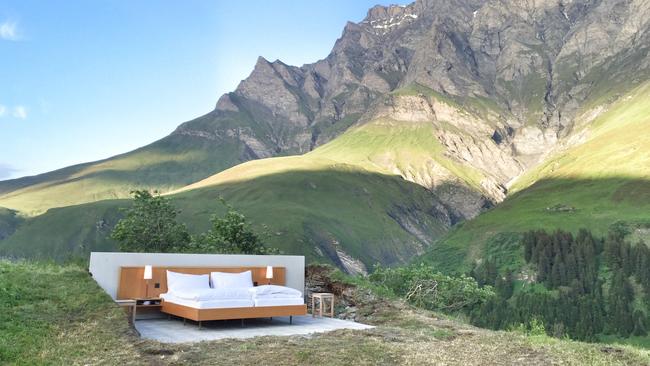
When is a good bed, a nice ensuite, a locking door and a reasonable view just not enough? Quite often, as it transpires. Research by Airbnb shows that interest in its Unique Listings selection in Australia has gone through the roof, with bookings increasing 60 per cent over the past two years.
Its most popular properties in this category include tiny houses, farm stays, orchard cottages, vintage vans, glamping retreats and singular examples such as Japanese Studio (pictured), a one-bedroom hideaway on a cool-climate garden estate of almost 4ha at Fitzroy Falls in the NSW Southern Highlands. Kyoto with kangaroos? Why not.
The range continues to evolve and now an international OMG! Category reveals the most zany of all, from sci-fi domes and Hobbit-style hideaways to a glass-walled cottage on a lava desert in the south of Iceland and an insulated aluminium airship-inspired pod overlooking Scotland’s Sound of Mull. Or how about a repurposed construction crane in Amsterdam, a comfortably converted bus on the outskirts of Kuala Lumpur or a double-decker in rural Portugal?
Airbnb launched the OMG! Category in June with a contest to fund 100 winners $US100,000 ($140,560) each to “design and build the most unique spaces around the world”. Entries closed late July and winners, judged by a panel that includes Australian architect Koichi Takada, will be announced next year. Watch these spaces.
In the meantime, Travel + Luxury writers have mined their memories of extraordinary accommodation, so read on for inspiration.
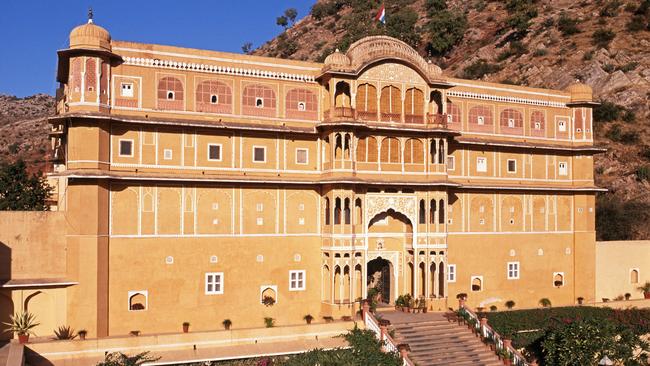
On the two occasions I’ve stayed at this fantastic confection, a Bollywood movie was being filmed. The sandstone pile is a favourite among filmmakers for its acreage, heritage architecture and frankly overpowering decor of ceramics, mirrors, handpainted archways, colonnades and curlicues. While palace hotels are not rare in India, this one, and its smaller haveli sibling in nearby Jaipur, form a small, privately run collective so the feel is intensely individual. The main palace hotel, brilliantly located near the Amber Fort, has ballrooms big enough for handsome heroes to gallop through on white steeds, and parapets just made for swordplay, consigning dacoits and rival suitors to their doom. Samode Palace was originally built as a Rajput fort, converted to a princely abode in the early 19th century and, while luxury is a given, it’s the thrill of (perhaps) being cast as an extra milling about the extraordinary Durbar reception hall, or the chance of bumping into Bollywood “royalty”, that constitute the bonus added extras. All chambers are sumptuous, and the feel is never less than otherworldly.
SUSAN KUROSAWA
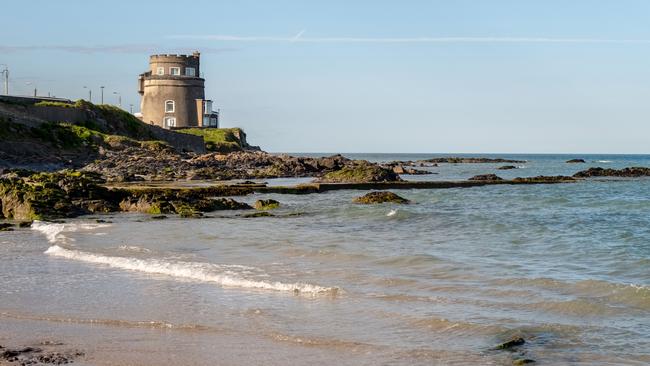
Although Ireland’s Martello towers were born of conflict, built in response to a possible invasion by Napoleon’s invading fleet in the early 19th century, they are now bastions of tranquillity across the Emerald Isle. But the only example where a party of travellers (maximum four per booking) can stay is perched on the cliffs of Red Rock Sutton, 12km from Dublin’s city centre, with wraparound views of Dublin Bay. Apart from the lure of its storied past, the tower is an utterly unique place to nest. The circular shape, Napoleon-proof stone walls, corkscrew-twist staircase, and design quirks are an enchantment. Mod cons such as Wi-Fi access and a jacuzzi soften the military edges. With 10 golf courses nearby and the trails of Howth Head at the door, this city experience still shows off Ireland’s unforgettable greenery.
CLEO GLYDE
The Tower, Mount Ophir Estate, Rutherglen, Victoria
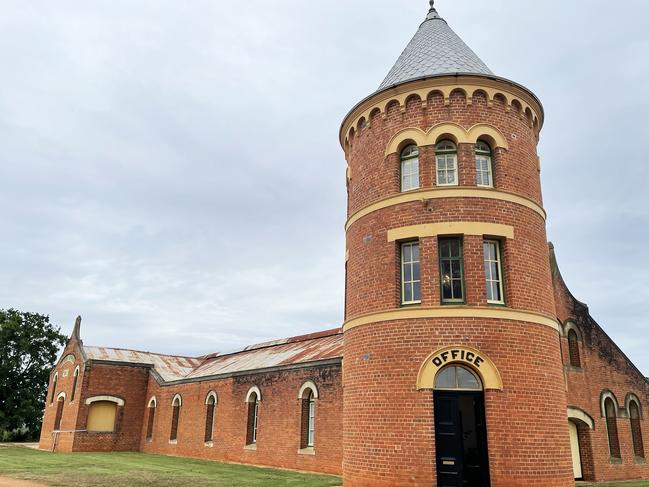
Rapunzel would feel at home in this historic building, as well as providing an access solution, such is the tightness of the corkscrew staircase connecting the ground-floor kitchen/dining area to the first-floor lounge/library with its pressed metal walls. Ladder-like stairs then ascend to the bedroom that looks out across the estate, which in the early 1900s was the largest wine facility in Australia but now sits in a state of lovely decrepitude. You can almost smell past vintages while wandering through the abandoned winery and outbuildings. The circular tower, however, which was the manager’s office, has been tarted up, albeit with vintage touches such as chandeliers operated by pull cords, while guests’ welcome notes are produced on an antique typewriter.
JEREMY BOURKE
Hotel Le Corbusier, Marseilles
Forget chateaus and Riviera-adjacent resorts, this is “the” French hotel, housed within a brutalist residential building on the outskirts of Marseilles, that draws architects and lovers of design. When Swiss architect Le Corbusier designed the UNESCO World Heritage building La Cité Radieuse 70 years ago, his aim was to create what he called “the machine for living”. Indeed, the self-contained structure has a shopping arcade, restaurant, library, pool, solarium, weekly film club and, on the top level, abundant recreational space featuring major art exhibitions. On the third and fourth floor, among the tightly held two-storey apartments is Hotel Le Corbusier, which features 21 simple (and well-priced) light-filled rooms, with original details intact, including Charlotte Perriand-designed Nemo lamps.
ANDREA BLACK
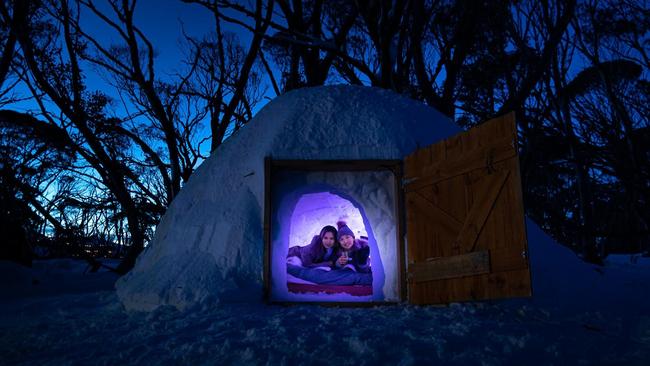
Alpine Nature Experience Igloo, Mt Hotham, Victoria
While growing up in the French Alps, Jean-Francois Rupp probably never imagined he’d one day be building igloos in the Australian High Country. The mountain-loving Frenchman has created not just igloos, but a hidden ecovillage nestled among century-old snow gums near Mt Hotham, in the Victorian Alps. Guests can live as an Inuit as part of Alpine Nature Experience’s “Igloo to skidoo” overnight adventure, which includes a snowshoe hike, mulled wine, fondue dinner (Rupp’s grandma’s secret recipe) inside a Nordic tipi, and a skidoo ride out. It’s a balmy 4C inside the igloos, but -10C-rated sleeping bags and sheepskin blankets keep guests toasty. Igloos are snow-dependent, of course, so alternative lodgings are in a snowdome, with wood fire and sky view. June to September only.
RICKY FRENCH
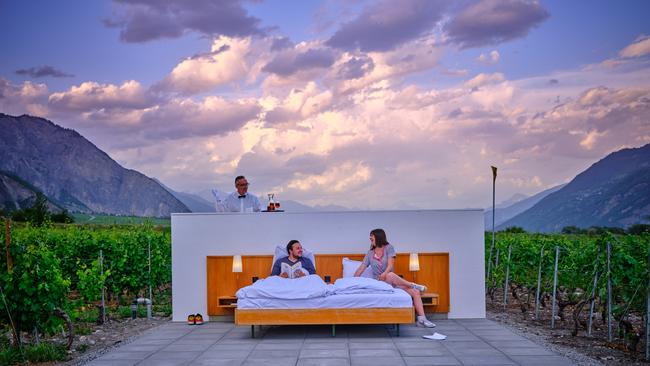
Who needs a hotel room with walls, or even a ceiling? In the mountains of Switzerland, from July to September, there’s the option of “zero real estate suites”, meaning a bed and bedside table plopped in the middle of a picturesque landscape for a night under the stars. The location changes annually; this season featured three suites in a vineyard overlooking the medieval village of Saillon and the Rhône valley. If that sounds too comfortable, the Anti-Idyllic Suite is the latest kooky addition. Set up in a roadside petrol station, guests get to spend a sleepless night reflecting on current world crises such as climate change, the economy, resources and security. But there is breakfast and butler service.
CINDY FAN
Shack Up Inn, Clarksdale, Mississippi
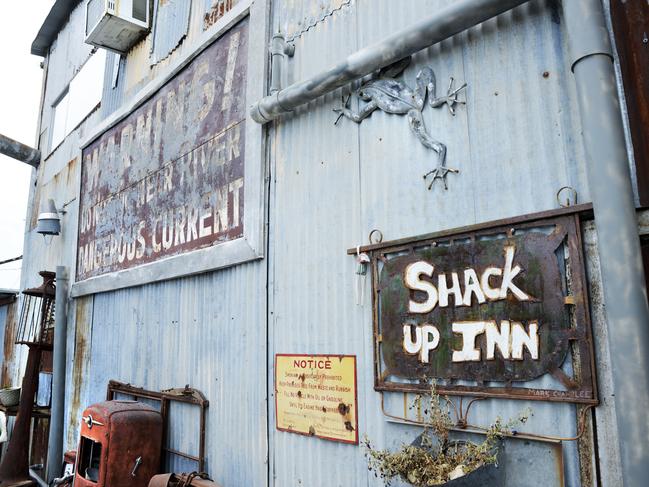
A collection of barely renovated sharecropper shacks, transported to what was once a pioneering cotton plantation near Clarksdale, is the ultimate atmospheric stay for blues lovers grooving through the South on a musical pilgrimage. These simple shotgun houses (superstition has it that ghosts can pass right through, as well as bullets down the hall) might include rocking chairs on the porch, tin ceilings, graffiti-scrawled walls, patchwork quilts and maybe a piano. Other options here include checking into a grain bin, with interiors fashioned from barn timber, or a room within the Cotton Gin Inn. There’s a music venue on-site or roll into Clarksdale, 5km away. The tiny city, considered the birthplace of the blues, also houses the Delta Blues Museum.
KATRINA LOBLEY
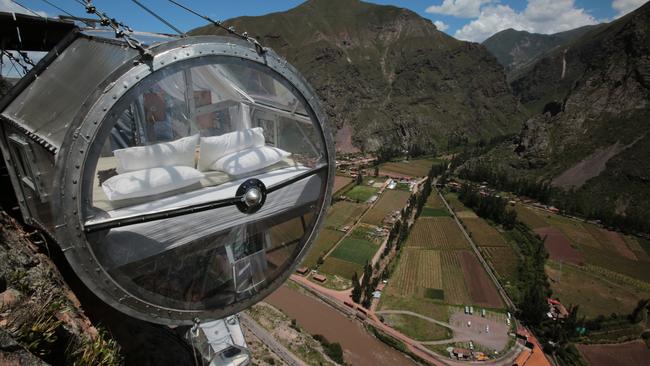
Skylodge Adventure Suites, Peru
Precipitous is one way to describe these lodgings; vertigo-inducing is another. Suspended from a cliff 400m above the ground, the three Skylodge capsule suites take glamping to a whole new level. Each is made from aerospace aluminium wrapped in clear polycarbonate, which ensures a bird’s-eye view of Cusco’s dreamy Sacred Valley. And each comes with four beds, a dining area and even a private bathroom, with solar power feeding the lamps when night falls. Just getting here is an adventure, with guests hiking up the mountain using a via ferrata (steel ladder and cable) system; departure is by zip line. There are curtains to enclose the nook, should you wish for privacy. But in reality, the nearest neighbour will likely be a condor.
NATASHA DRAGUN
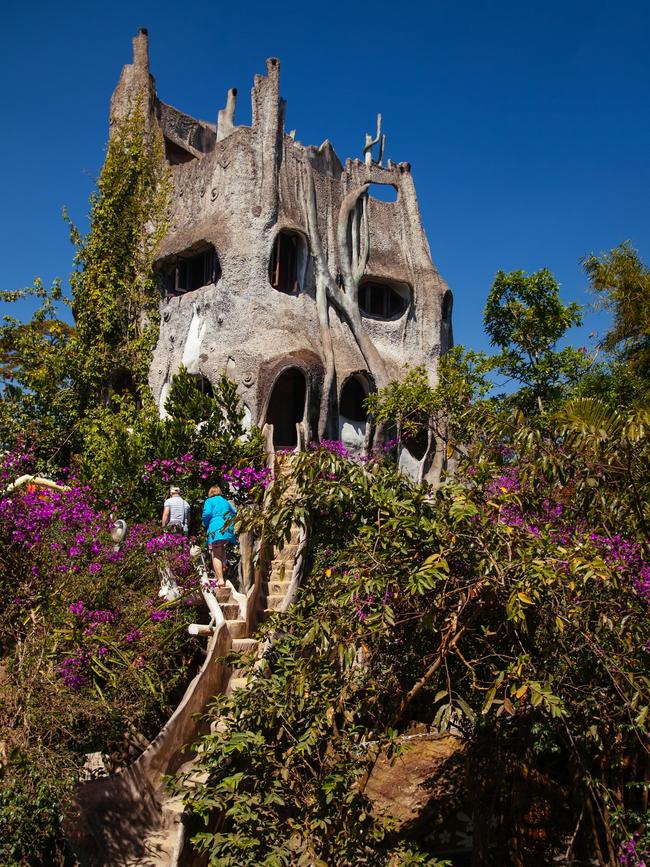
This bizarre property fully lives up to its name. Weird, wacky concrete tree houses of all shapes and sizes are each connected via narrow branch bridges and cave-like stairs. The whimsical guesthouse in the central highlands of Vietnam comes from the imagination of Dang Viet Nga, who studied architecture in Moscow before returning to her homeland to build this surrealist fantasia. It’s as if Dali conjured up a gothic Hobbiton, complete with melting walls, undulating surfaces and gnarled forms inspired by tree roots. It feels like a fairytale. Daytime visitors can clamber around and explore the many nooks and passageways, while overnight guests have a choice of 10 rooms, each with its own eye-popping theme based on a plant or animal, from gourds to kangaroos.
CINDY FAN
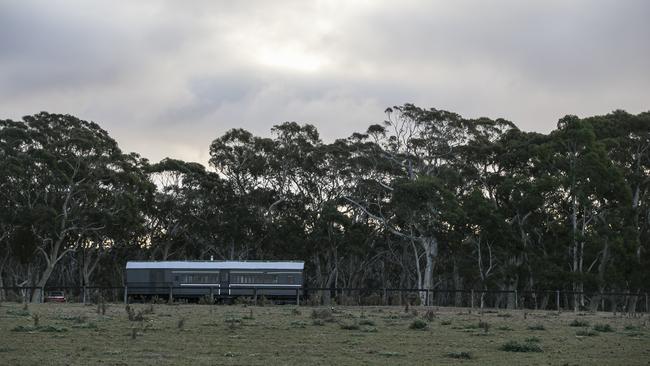
Redleaf Carriages, Fitzroy Falls, NSW
Generally when on a train, you’re the one whizzing past bucolic scenes of wildlife and livestock. But if staying in either of two converted train carriages (one circa 1890; the other from the 1920s) set on a 28ha farm in the NSW Southern Highlands, it’s the scenery on the move. Guests simply need to sit back, relax and watch. Sheep wander up as the sun sets. Crimson rosellas dart across the sky. A few paddocks over you might spot donkeys or the farm’s shaggy Highland cattle. And there’s plenty to observe inside, too, from pressed-tin ceilings to 1920s graffiti to an antique zinc bath. Sometimes staying still can be even better than a journey.
ALEXANDRA CARLTON
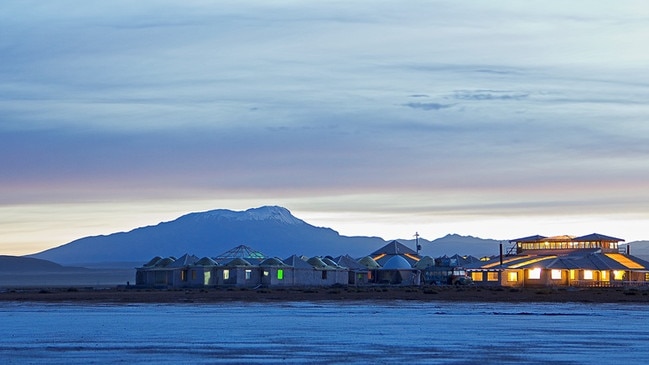
Salar de Uyuni, the world’s largest salt flat, covers more than 10,000sq km of Andean countryside. So why not use what’s on the doorstep to build a hotel? Welcome to Palacio de Sal, a 42-room abode built from what else but salt bricks. More than a million, in fact, which employees shave down from time to time to keep angles crisp. Each room has an igloo-style dome roof, also made of salt. Lick the bedhead, if you dare, and you’ll taste … salt. Naturally, the spa incorporates the mineral into treatments, with a soak in pools laden with sodium chloride, said to ease aches and pains and speed up healing. The second-storey observation deck, offering unbroken views over the blinding white flat, is particularly pretty after rain when it transforms into a giant mirror reflecting the clouds.
NATASHA DRAGUN
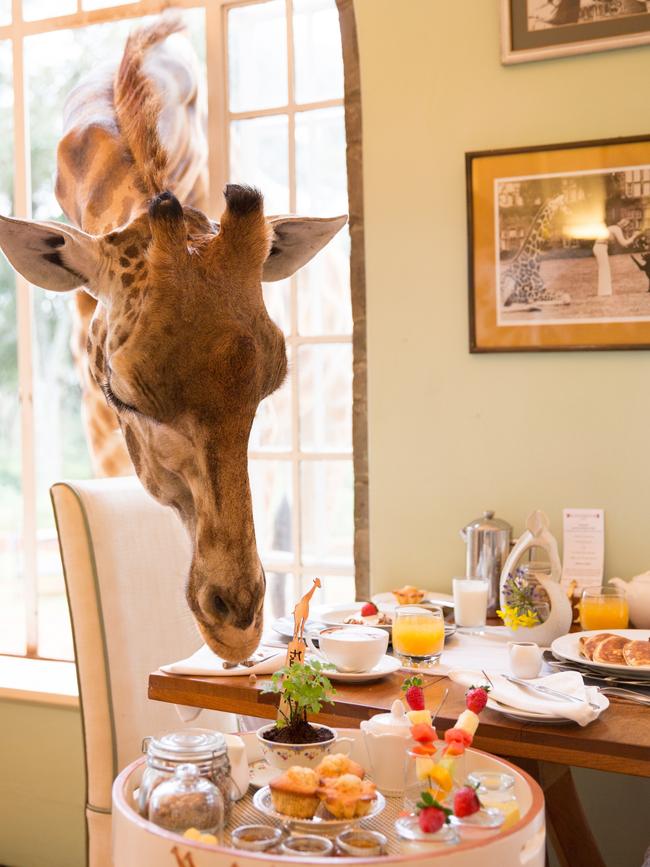
While this urban property on a sprawling forested estate can’t compete with the full African safari experience, there’s something magical about a giraffe poking its long neck through the tall dining room window and (seemingly) fluttering long lashes in the hope of treats (approved pellets, not croissants). Located next to the Kenyan capital’s Giraffe Centre, the 1930s English-style manor is home to a herd of the Rothschild’s species that seem to graze around the clock. Creature comforts for humans include 12 huge suites across the main manor and a newer replica building; the panelled dining room is candlelit for dinners. Staff “orchestrate” the giraffe encounters so there’s no sense of being in the wild and while it can err towards a novelty experience, Giraffe Manor has long been a breeding centre for Rothschild’s giraffes, and numbers have reached more than 1000 in the wild, from a 1970s low of just 80.
SUSAN KUROSAWA

To join the conversation, please log in. Don't have an account? Register
Join the conversation, you are commenting as Logout